
Mechanical Dredge – Excavator
Mechanical Dredge – Excavator
Mechanical dredges are designed to dig or excavate sediment, muck, or sludge from the water, even below the surface
Barge mounted and Amphibious excavators can remove sediment without draining the lake, pond, or lagoon
Lakes, ponds, or lagoons can be drained with an outlet control structure, pump, or siphon system
Mechanical Dredge – Excavator
Clean out a pond, lake, or lagoon: You can dig it!
Mechanical dredging refers to digging or excavating sediment from a waterbody, in contrast to hydraulic dredging that pumps sediment from a waterbody. Typically, mechanical dredging is done by a backhoe, excavator, dragline, or crane of some type. Excavators, or backhoes as commonly referred to as, have really become the industry standard for most inland mechanical dredging projects. Draglines are cranes equipped with special buckets that can “thrown” and retrieved with cables to remove sediment. Draglines are still efficient in many mining applications but have largely been replaced by modern excavators that are more precise and efficient. Clamshell dredging is another type of mechanical dredging in which a bucket is lowered straight down to the bottom where it then squeezes together to grab sediment to raise to the surface. This method is more effective on large, deep, spot dredging projects in harbors and in the ocean.
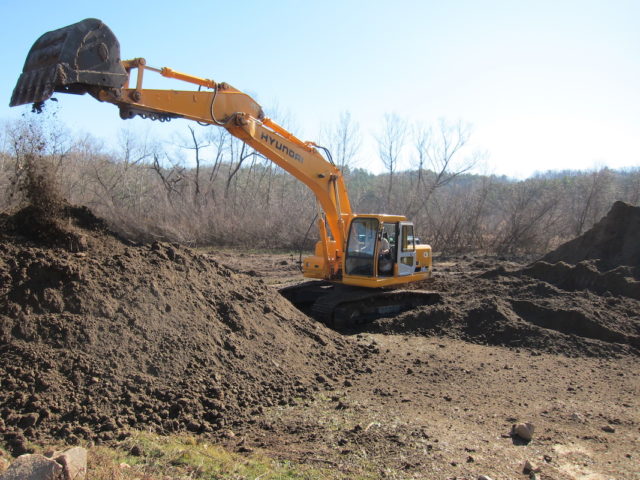
Long reach excavators (aka long arm, long boom, long stick excavators)
River Sand incorporates the use of several types of specialized excavators for its mechanical dredging projects. The most common type is the long reach excavator. Long reach excavators are fitted with a longer boom and smaller bucket to enable it to reach a further distance. The reach of a standard excavator is doubled or tripled with a long reach boom. Typically, small mini and midi excavators can extend the reach along the ground from 12-15’ to 15-25’. Larger excavators are the most commonly types and extend a standard range boom from 20-30’ to 50-70’. The extended boom allows the operator to remove sediment from the stable shoreline up to 70’ out into the lake. It also allows you to relay or place material the same distance from the machine. The advantage is that you can move sediment over 100’ in distance in one rotation, which is impressive. Often the excavator can load or dispose of material without having to reposition. Furthermore, the excavator can place wet, sloppy sediment away from the machine so that you can continue to work while sediment dewaters off to the side. Long reach excavators are not as efficient or stable with grading projects and standard earth moving so they are a specialized piece that you typically see within a certain type of project. Mats or matting systems can be used to traverse over and within the lake, pond, or wetland without sinking in the mud.
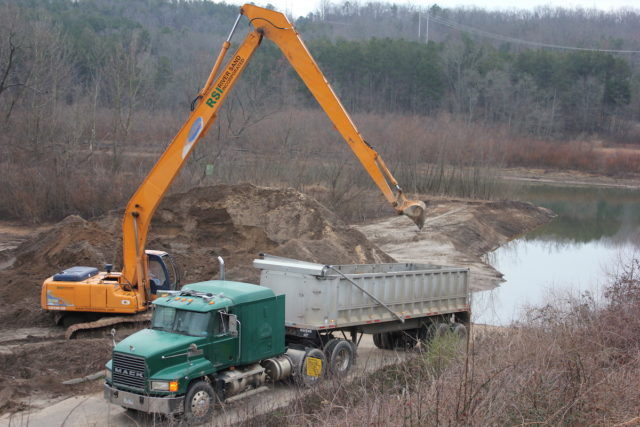
Amphibious Excavators
Amphibious excavators, sometimes called marsh buggies, are another type of mechanical dredge. Unlike traditional excavators, the track system is replaced with a large, tracked pontoon on each side. The tracked pontoons allow the excavator to travel and dig on land, mud, or water. The excavator is able to relay sediment to the shoreline, load a barge, or assist a hydraulic dredge. Amphibious excavators are available in any sized excavator. Another type of amphibious excavator is our “Spydee”. It is mounted on four legs with wheels on the ends and capable of standing up or squatting down with four legs, or even walking over sea walls. The boom extends and the bucket rotates for all managing many angles and hard to reach areas.
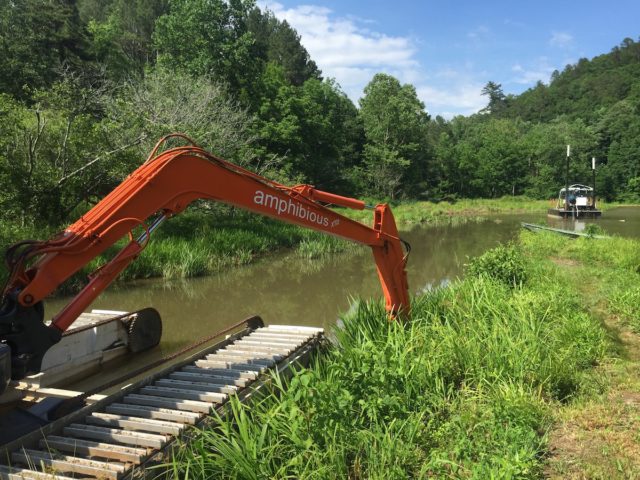
Barge Mounted Excavator
Barge mounted excavators are another option for mechanical dredging. Long reach excavators are best suited to mount on a barge so that you can reach far enough away from the barge and relay material to another barge or the disposal area. The barge usually requires 4 to 6’ of water to float. This process can be very efficient and effective for dredging as well.
Key benefits of mechanical dredging, excavation:
- Removal of sediment and large debris regardless of size
- Efficient removal from the shoreline
- No need for large pond or dewatering area on-site
- Easily removes vegetation including roots, woody debris, and logs
- Shoreline cleanup is effective and aesthetically pleasing
- Access to areas that dredges cannot float
- Various sized machines and capacities available
- Can walk on land or water for dredging with water level up or down
- Dredging possible with lake drained
- Dewatering can occur within the lake itself
- Excavator can dredge, clear debris, and grade spoil area
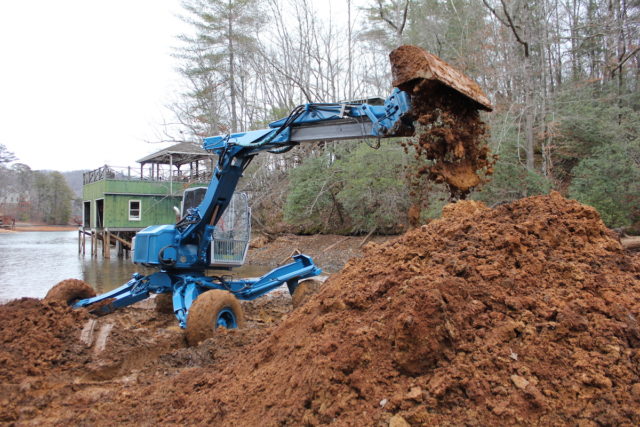
How far can a long stick excavator reach?
The most common sized excavator with a long stick boom will reach 60’. These excavators typically range in weight from 50,000-100,000 lbs. The bucket size and capacity as well as counterweight are all factors involved in the efficiency of the machines as well.
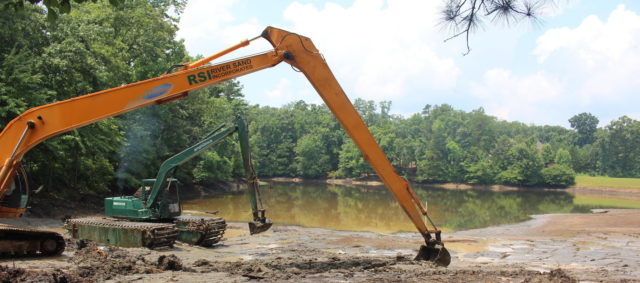
What is a backhoe dredger? How does a backhoe dredger work?
A backhoe dredger is really referring to an excavator used for dredging. The can be barge mounted or on tracks. Backhoe dredgers have an engine that powers a hydraulic pump that supplies fluid to move the boom, or arm, and bucket into position to scoop up muck and sediment. The excavator can then lift the bucket and rotate at the same time to place the muck into another area, a truck, or a transport barge. Backhoe dredger can be fitted with DGPS equipment and software to track dredging progress for efficient and precise removal.
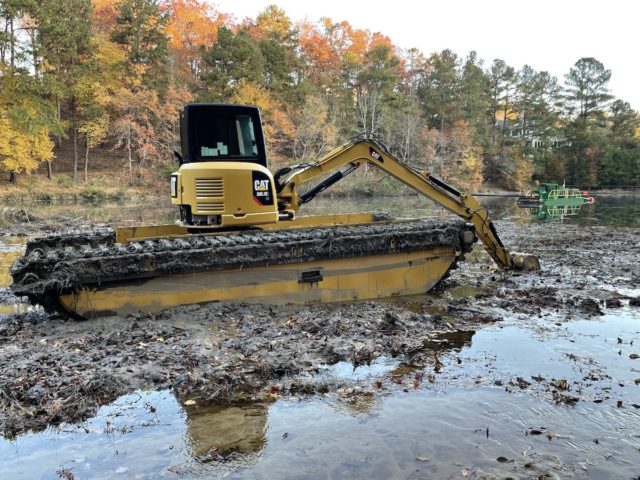
Can I use a bulldozer to clean my pond?
A bulldozer is sometimes a great piece of equipment to build a pond, but it typically isn’t the preferred choice to clean out your pond. Bulldozers utilize their blade to push dirt from one area to another. Muck or mud on the bottom of a pond may take a very long time to dry out enough to push with a blade. Furthermore, the lake or pond must have a hard enough bottom for the bulldozer to travel without sinking into the mud. It is this reason that excavators are a more common machine to remove sediment from a lake. Excavators can move muck while positioned on stable ground or mats to prevent sinking while working.
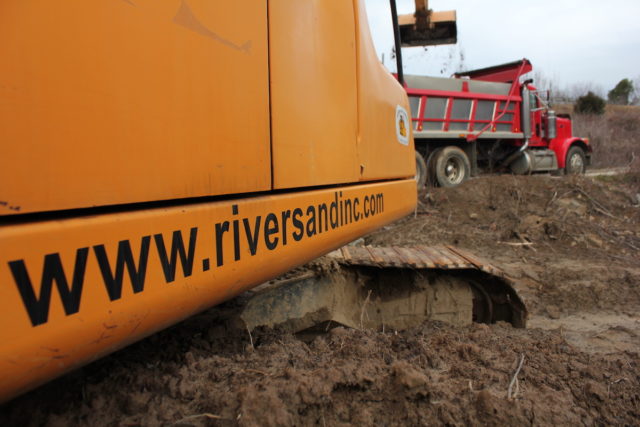
River Sand – Excavation Dredging
River Sand uses excavators every day in our field of dredging. We have all sizes and types. Excavators for dredging are a must. Our equipment fleet includes various sizes of long reach excavators, amphibious exavators, barges for mounting excavators, and excavator attachments for other tasks with dredging. Digging out your pond or lake can be as simple as giving us a call. We offer turn-key dredging projects and many of our clients are very surprised at the low-impact methods we implement to keep your property in great shape during the process. The final result will look great when we complete your dredging project!
Frequently Asked Questions
Do you have questions about River Sand? We have answers!
Raw water intakes along rivers and streams can clog during large flooding events or over time. Bar screens and travelling screens can prevent certain debris from entering the stilling well, but over time logs, sticks, and sediment may clog the intake. Debris can be cleaned with an excavator is access is available. Cleaning can also be done manually by hand but this can be a tedious process. Another option for fine sediment clogging the intake is using a hand-operated dredge with diver-assistance. Sediment can be removed from the front on an intake and from within the stilling well or between the screens.
Determine the characteristics of the sediment that you need to pump including the distance and vertical head. Select a pump based on its pump curve that can perform sufficiently for the project. Select an engine that has the power requirements for the pump. Determine the weight required for the pump and engine. Build the barge capable to float and balance the weight of the engine and pump. Most portable barge sections are built in 4’, 6’, 8’, 10’, or 12’ widths for transport. Attach a ladder and cutterhead capable of desired dredging depths and pump capability.
A dredge alone usually is limited to about 2000 feet of pumping distance. However, there are many factors that can limit or increase this distance. Dredges along with booster pumps can essentially pump an indefinite distance but in most cases it becomes unfeasible economically.
Standard size mini-ex’s can reach from 12 to 20 feet along the ground. Bigger excavators can reach from 20 to 30 feet along the ground with 25 feet being the average distance. Long reach excavators usually reach from 30 to 60 feet out. The 60 feet reach is the standard size long reach excavator. Specialized long reach excavators (not typically available) can reach 70 to over 100 feet.
A small dredge starts about $125,000. A typical dredge cost between $500,000 and $1,000,000. Larger portable dredges cost $1,000,000 to $10,000,000.
Related Articles
See what we’ve been saying about
River Sand
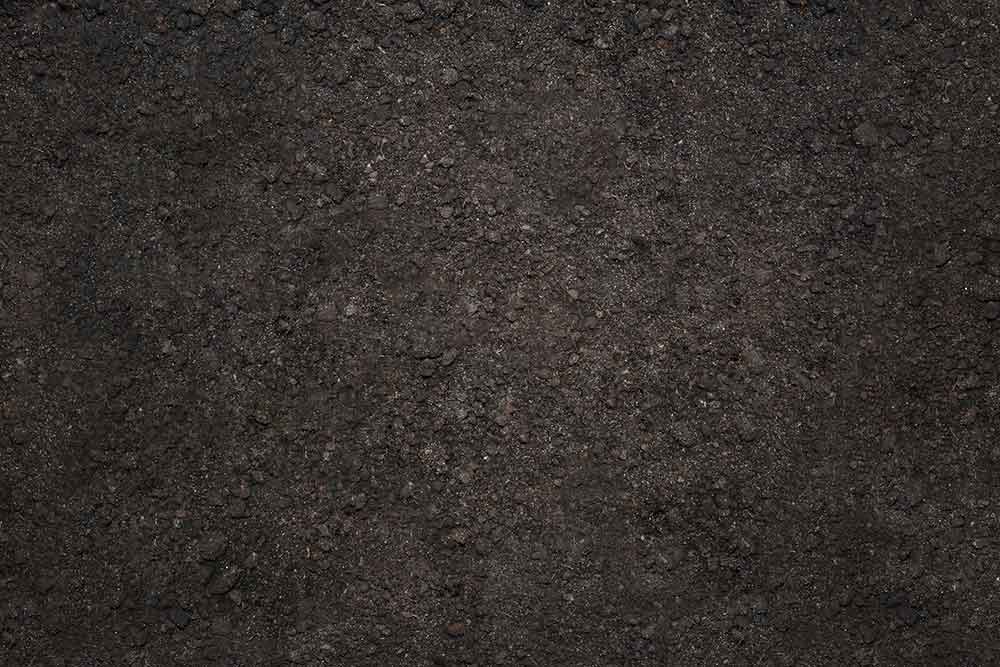
“It’s my pleasure to recommend River Sand, Inc. for their great job in the dredging of our HOA’s community property Lake. River Sand’s expertise and direct experience made the business of contracting this significant job much easier, and every expectation of their service on the work project was exceeded. It was terrific to deal with a company that has over delivered on all promises.”
— Scott P. | Committee Chair
Related Products
Calculate Your Project
Determine how much product you need for your project and submit it to us for a free estimate, including delivery costs.
Dredging projects and In-Field Mix are calculated separately.

